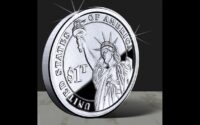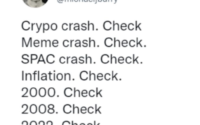How Stalling Inflation Data May Concern The Fed And Affect Rate Cuts
Federal Reserve Board Chair Jerome Powell speaks during a news conference about the Federal … [+]
The U.S. Federal Reserve is likely to cut interest rates in 2024. But recent strong jobs numbers and potentially discouraging inflation data might delay any rate cuts until the summer. That’s based on market expectations, where an earlier cut was previously viewed as likely. Inflation is down significantly from peak levels but there is some chance its underlying level has stalled closer to 4%, rather than trending toward the Fed’s 2% annual goal.
Recent Inflation Data
Consumer Price Index monthly inflation has risen sequentially since October 2023. This suggests the disinflationary trend may have somewhat stalled. However, it’s important to note that inflation hasn’t materially risen on an annual basis. It’s just stopped declining for now.
Also, the Fed prefers to use the Personal Consumption Expenditures series, where inflation trends currently appear to be more encouraging. However, the series will be updated for January on February 29. If the CPI release for the same month is any guide, PCE inflation data may show a material increase.
Nowcasts
Unfortunately, nowcasts suggest inflation data could get a little worse too once figures for February are reported. The Cleveland Fed’s model suggests that February’s data may also challenge the narrative of cooling inflation. Headline CPI might rise 0.42% for the month and PCE inflation may rise 0.29%.
Again, this forecast — if it holds — doesn’t suggest a major resurgence in inflation but rather that it may be level out at a point significantly above the Fed’s 2% annual inflation target. This, together with relatively robust jobs data, means that the Fed is holding back on interest rate cuts for now.
Services Prices Aren’t Sufficiently Cooling
The problem is services costs. Goods prices have continued to be subdued, with some categories such as apparel and vehicles falling in absolute terms depending on the month.
In contrast, services costs have continued to rise. This category includes areas such as housing and transportation as well as medical needs. The Fed was expecting that shelter costs might move lower in the CPI series, following the overall dip in U.S. home prices in late 2022. Yet so far, that hasn’t been evident in the CPI shelter cost series. Similarly, as wage costs have moderated, the Fed was looking for services costs to cool. But again, there hasn’t been much evidence of that yet in inflation data.
The Fed Remains Broadly Optimistic
However, despite potential concern from monthly inflation readings and nowcasts, the Fed remains broadly encouraged by the cooling inflation trend. As Fed Chair Jerome Powell said at his last press conference on January 31, “The lower inflation readings over the second half of last year are welcome. But we will need to see continuing evidence to build confidence that inflation is moving down sustainably toward our goal.” Powell has also hinted that the Fed expects current interest rates are at peak levels, and so a cut is increasingly likely from here.
Still, if services inflation does not start to cool over the coming months, then the Fed may be tempted to hold interest rates at current levels for longer. Fortunately the Fed has the luxury of doing so, since the jobs market has remained robust to date.
[ad_2]
Source link


